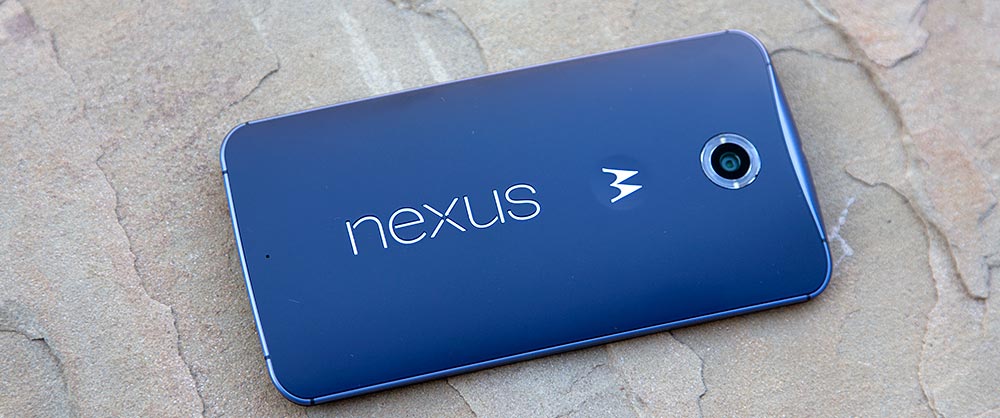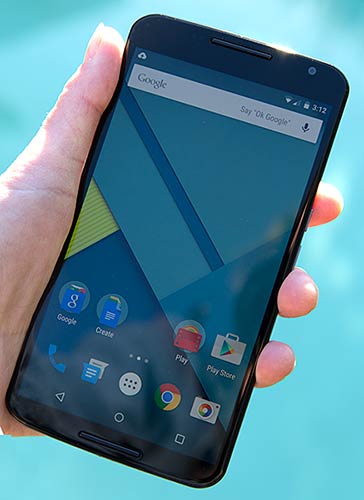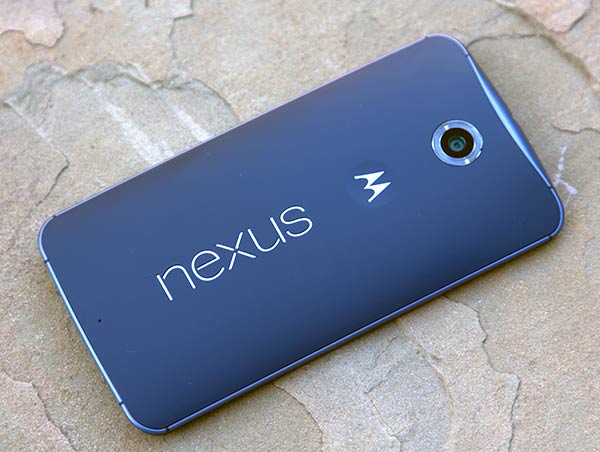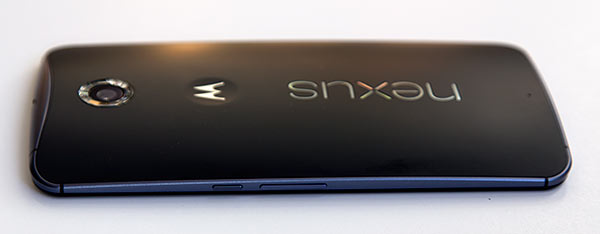Google Nexus 6 Full Review
12:42 When a smartphone is codenamed after a killer whale (Shamu), Google is putting the world on notice. Or the designers realized this is one whale of a phone. At 6", the display is as large as the Amazon Fire HD 6's and just an inch shy of the Nexus 7 tablet's 7 inches. Have no fear; the Nexus 6 itself is considerably smaller than those tablets, though it makes the 4.7" iPhone 6 and Sony Xperia Z3 Compact look like children's things (albeit really nice children's things). It's not wildly larger than the Samsung Galaxy Note 4 in terms of footprint, though it's not as slim as the Note 4. Phablets are the rage this year, and the Galaxy Note went from a specialty item to a mainstream phone over the past few years, so I won't harp on the Nexus 6's size. Phone size is a personal decision and one that you should make for yourself. That said, if you haven't used a big phone, I do suggest visiting a store and trying it out for hand and pocket friendliness. Fortunately, the big 4 US carriers will offer the Nexus 6, so you should be able to see it in person.
When a smartphone is codenamed after a killer whale (Shamu), Google is putting the world on notice. Or the designers realized this is one whale of a phone. At 6", the display is as large as the Amazon Fire HD 6's and just an inch shy of the Nexus 7 tablet's 7 inches. Have no fear; the Nexus 6 itself is considerably smaller than those tablets, though it makes the 4.7" iPhone 6 and Sony Xperia Z3 Compact look like children's things (albeit really nice children's things). It's not wildly larger than the Samsung Galaxy Note 4 in terms of footprint, though it's not as slim as the Note 4. Phablets are the rage this year, and the Galaxy Note went from a specialty item to a mainstream phone over the past few years, so I won't harp on the Nexus 6's size. Phone size is a personal decision and one that you should make for yourself. That said, if you haven't used a big phone, I do suggest visiting a store and trying it out for hand and pocket friendliness. Fortunately, the big 4 US carriers will offer the Nexus 6, so you should be able to see it in person.
Google, as always with Nexus devices, also sells it direct from the Google Play website if you're OK paying $649 full retail up front for the unlocked Nexus 6. The Nexus 6 supports both GSM and CDMA networks and 12 LTE bands, so the single available model works on the big 4 US carriers (and some smaller carriers). The carrier model sold in your local store is physically the same, but it will have a few carrier apps pre-installed such as an account management app, but it won't carry the usual hefty load of bloatware. The T-Mobile version is unlocked, and the Verizon Wireless version will be unlocked because all of their 4G LTE phones are unlocked due to government requirement. The Sprint version is also unlocked but the AT&T version sold in AT&T stores is locked to AT&T. AT&T also places their own boot screen on the phone and graces the back (ahem) with their logo. For those of you who love to root and play with alternative ROMs, true to Nexus form, all have unlockable bootloaders.
The Nexus 6 marks Google's return to flagship level phones. The first Nexus was very high end in its day, but more recent models strove for decent specs with a very reasonable price tag. So Google's returning to the high line and as a result, the Nexus 6 should age well. This Android 5.0 smartphone is made by Motorola, a company that Google owned during the Nexus 6's development period (Lenovo recently took over Motorola Mobility). Moto's design language shines through here and the Nexus 6 looks like a really big 2014 Moto X, minus the customizable back options. Sorry, there's no wood or leather here, but you do get a robust metal frame, a rigid polycarbonate back and two color choices: blue or white. They're matte and our blue model adores fingerprint oil (you'll need a damp rag with a hint of liquid hand soap to clean them off).
Think of the Nexus 6 as an even more well-endowed 2014 Moto X. It runs on the even faster Qualcomm Snapdragon 805 quad core processor clocked at 2.7GHz with Adreno 420 graphics, and it has a lovely QHD 1440 x 2560 AMOLED display. Bigger phones allow for larger batteries, so the Nexus has a 3220 mAh battery (the same capacity as the Galaxy Note 4). The battery is sealed inside and it supports Quick Charge 2.0 and Qi wireless charging. Other amenities include dual band WiFi 802.11ac, Bluetooth 4.1, NFC, a GPS and LTE 4G on 12 bands. It has a rear 13MP camera with 4K video recording and a front 2MP camera.
Design and Ergonomics
If you've seen second generation Moto X (colored plastic versions, not the wood or leather versions), then you'll have a good idea of the Nexus 6's styling and materials. The metal frame is robust and is both structural and part of the visual design. The back is solid with no creaks and all seams meet cleanly with no unsightly gaps. No, it's not a unibody metal phone like the iPhone 6 Plus and HTC One M8, but the Moto X and even the Nexus 6 manage to look like quality pieces--I don't believe a metal casing is required to make a phone look and feel like high end goods. Designs often look less attractive when significantly sized up, and I'd argue that the iPhone 6 Plus is less attractive than the iPhone 6. The Nexus 6 doesn't look quite as stunning as the Moto X, but it's 90% there, which is impressive since it's hard to make a 6" phone look good and still feel like a phone rather than a tablet. Moto's distinctive design language is a plus: no one else does the compound curves and palm-friendly backs the way Moto does.

In terms of comfort, big hands are recommended, though those with small hands can two-hand it. It honestly feels a little silly holding such a big phone to my head when making a call, but these days so many folks use big phones that no one stares. The Nexus 6 is a little bit bigger than the 5.7" Note 4 and it's thicker than both the iPhone 6 Plus and Note 4. Given the size of the phone, Motorola and Google dropped the power and volume buttons down toward the middle of the right side since most folks' fingers might not reach to the upper half when holding the phone with one hand. Unlike iOS 8 and TouchWiz on the Samsung Galaxy Note 4, there's no real concession to one-handed use like dropping the UI down as with the iPhone 6 Plus or dropping the dialer screen down and to the side with the Samsung. The phone's back curves make it comfortable in the hand (again, assuming large enough hands) and the tapered edges make for a slim looking phone. The sides have straight enough edges to provide better grip without digging into your hand.
The back isn't removable, and thus the battery is sealed inside. iFixit has taken the Nexus 6 apart, and it's apparently quite serviceable, unlike some sealed phones. There's no microSD card slot and the nano SIM card slot lives under a door that releases with a paperclip or the included poke tool. We love the front facing stereo speakers located above and below the display. They're rich and loud, and give HTC's BoomSound stereo speakers in the HTC One M8 serious competition.
Calling and Data
Motorola makes good voice phones with strong reception; particularly strong reception on CDMA networks (Verizon and Sprint). The Nexus 6 has good reception on AT&T and T-Mobile (we're using the unlocked version sold by T-Mobile) and strong reception on Verizon Wireless. In a world where most Android phones use the same chipsets and radios, we don't see much variation between coeval models and brands, but the Nexus 6 and Samsung Galaxy Note 4 have the best reception in Verizon poor LTE coverage areas. Data speeds on the various carriers' 4G LTE networks were similar to other flagship phones. The Nexus 6 supports 12 LTE 4G bands and both GSM and CDMA, hence one model works on many carriers. We did notice when switching to a different carrier's SIM card that the phone took up to 5 minutes to register the change and find a signal. It sets data connection settings (APN) for you, so you don't have to worry about looking up and entering those.

Voice quality is very clear and full and volume is average. Given the size of the phone, it's easy to hold the phone too low with the earpiece below the ear canal (hint, raise the phone and voila, incoming volume is fine). The mic location isn't an issue since modern smartphone mics are designed to work well in a variety of positions and even distances. Our call recipients said we sounded particularly loud and clear on the three carriers we tested (we didn't have a Sprint nano SIM handy to test on that network). Our T-Mobile unit doesn't have support for WiFi calling, but T-Mobile has said that will be coming. We expect voice over LTE (VoLTE) some time next year, which Verizon also calls Advanced Calling.
Display
Nexus phones, not unlike the top Samsung models and the iPhone, are scrutinized heavily by both reviewers and shoppers. There's only one Nexus a year, and even when it's priced in the midrange, folks have high expectations. Thus the poor Nexus 6 has already been praised by reviewers (for the most part) and pummeled by some shoppers, even before the phone has been available in significant quantities. So let's start with the facts: it's a 5.96" AMOLED QHD 2560 x 1440 display. That's impressive stuff--that's top dog resolution at the moment. Honestly, at 493 PPI pixel density, I don't hope to see even higher resolution smartphone displays because it's simply overkill. Samsung makes AMOLED displays, and most Galaxy models use this technology that provides super-saturated colors, near infinite contrast and deep blacks. Whites and brightness aren't AMOLED's strong points, though Samsung has managed to get some impressive brightness out of the Samsung Galaxy Note 4. The Nexus 6 display looks brighter than the 2014 Moto X (also AMOLED but 1080p) and Motorola Droid Turbo, but its auto-brightness setting is simply too dim. It you look at it in a store where the factory default adaptive display setting is enabled, it will look dim next to the Note 4. Disable that and set brightness to 50% in manual mode and it perks up quite a bit. It's actually a decently bright display, even though it can't match the Note 4's retina-burning max brightness. It's viewable outdoors in sunlight and it's more than bright enough for indoor use. Colors are warmer than on the Note 4 and many other competing phones as well as laptops. That's fine with me because it's closer to a proper white point--these days most devices are much too cool (toward the blue rather than yellow) from the factory. I do miss Samsung's color options though--there are no color saturation and temperature settings here. Remember, it's vanilla Android so you don't get manufacturer tweaks and apps to enhance the basic Android experience. While it doesn't beat the Note 4, it's nonetheless a lovely and very sharp display. Horsepower and Performance
In a way there's little to say here, because the Nexus 6 is downright fast and it uses what is currently the fastest Android phone processor on the market, the Qualcomm Snapdragon 805. The Nexus 6 and Galaxy Note 4 are the first two phones to use the CPU, and as you might expect given their identical resolutions, they benchmark very similarly. The 805 is a 32 bit processor (we'll have to wait for the Snapdragon 810 for 64 bit in an Android phone). Don't obsess too much over 32 bit vs. 64 bit just yet: the first benefit is the ability to address more than 4 gigs of RAM. No phone has more than 3 gigs, and RAM isn't upgradable, so 64 bit won't make a difference there. The other benefit is potentially faster application execution, which could be useful for extremely demanding apps like 3D games and video editing apps. It will take a while for developers to compile for 64 bit--you'd be surprised how many years it took Windows PC programs to make the change, and many iPhone apps are still 32 bit (Apple has mandated that apps have to support 64 bit by Feb. 2015).
Since the Nexus 6 runs clean and vanilla Android with no UI overlays or added applications that load at boot, it's as fast as an Android device with this hardware can be. The phone ships with Android OS 5.0 Lollipop, and will get OS updates quickly for quite some time. The Nexus 6 feels very fast and responsive--iPhone fast. It's doesn't suffer the occasional lag of Samsung TouchWiz phones and is zippy like the 2014 Moto X and Nexus 5 upgraded to Lollipop. Does navigating the app drawer and home screen feel faster than the Nexus 5 with Lollipop? Not really since both are more than capable of handling those tasks with great speed. Where you'll notice the difference is when playing a demanding 3D game like Asphalt 8, editing photos and videos and multitasking. Given how fast technology moves, it's hard to call any smartphone future proof, but the hardware here is good enough that the Nexus 6 won't feel like a dud in a year or even two.
The phone has 3 gigs of RAM, which is plush since it's running a clean and minimal OS and UI. You can get it with 32 or 64 gigs of storage. There's no microSD card slot for expansion since Google abhors removable storage, so if you like to carry a huge library of music or a healthy video library, go for the 64 gig model ($50 more expensive). Cameras
Motorola and Google have an abysmal track record with cameras. The Nexus 6 uses a 13 megapixel Sony sensor for the rear camera, as does the Moto X second gen, but the Moto X's camera failed to impress us. Happily, something went right here, and the Nexus 6's rear camera with f/2.0 lens actually takes very pleasing photos and good video up to 4K resolution. We hope some of that camera driver magic trickles back down to the Moto X! The camera app itself isn't ripe with features and settings, but the results are generally very colorful, balanced and bright with good lighting. The rear ring LED flash (two LEDs with a ring diffuser around the camera lens) helps in lower light and isn't overly harsh, and the Nexus 6 is a decent but not great camera in low light. It does a better job than the Nexus 5 and 2014 Moto X, but it doesn't come close to the iPhone 6 and 6 Plus. The Galaxy Note 4 isn't a superb low light camera either, but overall we give Samsung's camera the edge over the Nexus 6 for both good and poor lighting shots. We're particularly fond of the optical image stabilization (OIS) that helps reduce handheld camera shake that causes blurred photos and jumpy video.
The 2 MP front camera is good enough for video chat and decent though not wildly impressive selfies. Apparently Google doesn't put much stock in the front camera craze that HTC and Samsung cater to with higher resolution front cameras.
Battery
The Snapdragon 805 and 801 chipsets support Qualcomm Quick Charge 2.0, and Google happily includes a Motorola Turbo Charger (quick charger) in the box. If you've doubted those lofty claims that this charger can charge 30 to 50% in just a half hour--it's no lie. Given the high capacity 3220 mAh battery (same as the Note 4 that also ships with a Quick Charge charger), that's a lot of charging in a short time. Despite the big battery and Android 5.0's "Project Volta" for improved battery life, the Nexus 6 doesn't have miraculous runtimes. Rather the Nexus 6 is an all day and right up to bedtime phone, but it's not a 2 day beast if you're a moderate to heavy user. Google may improve Android 5.0's power frugalness, so there's hope, especially because the Nexus will receive more OS and firmware love direct from Google. That's not to say the Nexus has bad battery life, it's just not as wondrous as expected, and it falls short of the Samsung Galaxy Note 4 (same screen resolution, CPU, RAM and battery capacity) by about 30 to 45 minutes of screen on time.
The Nexus 6 supports Qi wireless charging out of the box. Given the curved back, it can be a bit challenging to position the phone on a wireless charging plate, but once you find the sweet spot (along the Nexus logo), it works well. Wireless charging isn't as quick as wired charging, let alone charging with the included Turbo Charger, but it's convenient.


0 comments